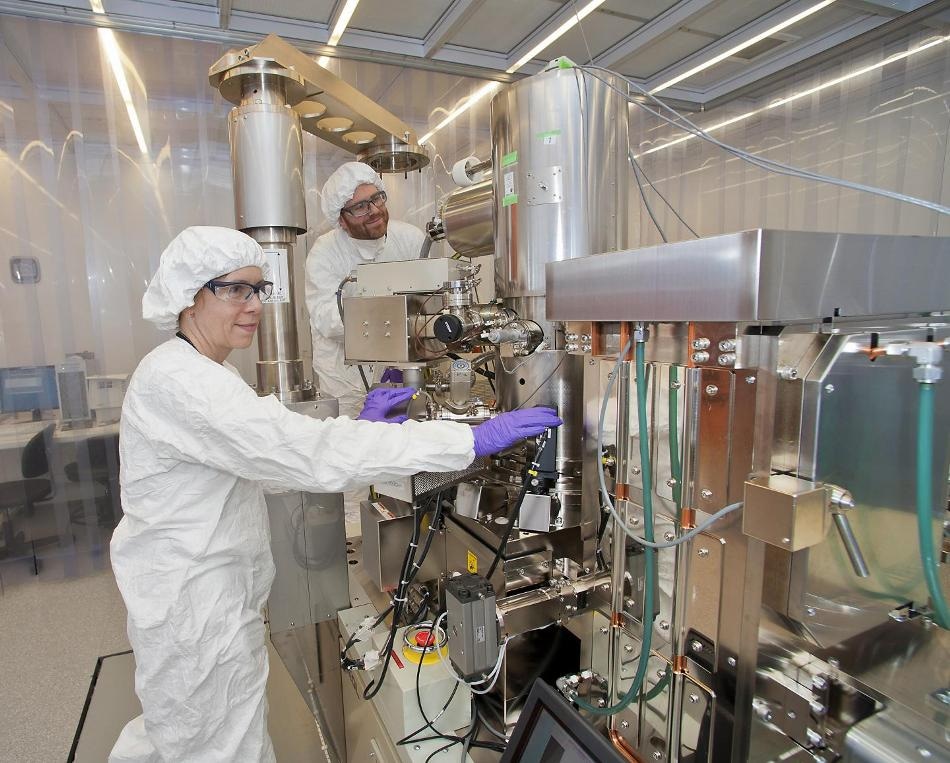Aug 10 2016
 Brookhaven National Laboratory Center for Functional Nanomaterials researchers Gwen Wright and Aaron Stein are at the electron beam lithography writer in the CFN cleanroom. (Credit; Brookhaven National Laboratory)
Brookhaven National Laboratory Center for Functional Nanomaterials researchers Gwen Wright and Aaron Stein are at the electron beam lithography writer in the CFN cleanroom. (Credit; Brookhaven National Laboratory)
Researchers at the U.S. Department of Energy's (DOE) Brookhaven National Laboratory have developed a new method to produce nanoscale architectures that combine together in intricate patterns with unparalleled efficiency.
In the new method, the self-assembly of various molecular patterns are directed inside a material, producing billionth-of-a-meter structures. In order to sustain advancements, sophisticated electronic devices should be able to manipulate the nanoscale, where materials measure billionths of a meter.
However, it is not easy to balance precision, complexity, and manufacturing scalability on such extremely small scales, but there are certain nanomaterials that could be snapped together into preferred formations through a unique self-assembly process. The results of the study have been reported in the Nature Communications journal.
This is a significant conceptual leap in self-assembly. In the past, we were limited to a single emergent pattern, but this technique breaks that barrier with relative ease. This is significant for basic research, certainly, but it could also change the way we design and manufacture electronics.
Aaron Stein, Physicist, Brookhaven National Laboratory
For example, strictly patterned templates are used by microchips to create small structures that are capable of processing and storing data, but during the self-assembly process, these structures will form unexpectedly without the use of those meticulously patterned templates. This self-assembly can create different distinct patterns, thus increasing the complex nature of nanostructures that can be produced in just one step.
"This technique fits quite easily into existing microchip fabrication workflows," said study coauthor Kevin Yager, also a Brookhaven physicist. "It's exciting to make a fundamental discovery that could one day find its way into our computers."
The trial study was performed at Brookhaven Lab's Center for Functional Nanomaterials (CFN), a DOE Office of Science User Facility, exploiting in-house instrumentation and expertise.
Cooking up Organized Complexity
As part of the collaborative study, the researchers used block copolymers, which are chains of two molecules joined together. These block copolymers were used due to their inherent ability to self-assemble.
As powerful as self-assembly is, we suspected that guiding the process would enhance it to create truly 'responsive' self-assembly. That's exactly where we pushed it.
Greg Doerk, Brookhaven National Laboratory
The researchers successfully produced precise yet simple substrate templates to direct the self-assembly. Then using the electron beam lithography technique, they etched patterns, which were many times thinner than a single strand of human hair, on the surface of the template. Following this, a solution comprising a set of block copolymers was added to the template; the resultant substrate was rotated to create a thin coating and finally baked in an oven to trigger the formation of molecules. The interaction between the template and the block copolymers occurred as a result of thermal energy, setting the last configuration, in this case, in dots or parallel lines in a grid.
"In conventional self-assembly, the final nanostructures follow the template's guiding lines, but are of a single pattern type," Stein said. "But that all just changed."
Lines and Dots, Living Together
Earlier, the same collaboration team found that combining different block copolymers resulted in the formation of various co-existing dot and line nanostructures.
"We had discovered an exciting phenomenon, but couldn't select which morphology would emerge," Yager said. However, the researchers found that when the substrate is modified, the emerging structures also change.
The self-assembling blocks can also be transformed into high-density arrays or ultra-thin lines of nano-dots by modifying the thickness and spacing of the lithographic line pattern, which, in turn, can be easily produced with contemporary tools.
"We realized that combining our self-assembling materials with nanofabricated guides gave us that elusive control. And, of course, these new geometries are achieved on an incredibly small scale," said Yager.
In essence, we've created 'smart' templates for nanomaterial self-assembly. How far we can push the technique remains to be seen, but it opens some very promising pathways.
Aaron Stein, Physicist, Brookhaven National Laboratory
Gwen Wright, another CFN coauthor, added, "Many nano-fabrication labs should be able to do this tomorrow with their in-house tools-the trick was discovering it was even possible."
The researchers are planning to improve the process further by using more complicated materials to advance towards more device-like designs.
"The ongoing and open collaboration within the CFN made this possible," said Charles Black, director of the CFN. "We had experts in self-assembly, electron beam lithography, and even electron microscopy to characterize the materials, all under one roof, all pushing the limits of nanoscience."